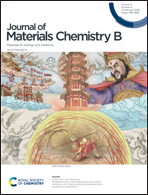Template-controllable rolling circle amplification for dual protein sensitive analysis†
Abstract
Conjoint analysis of multiple protein biomarkers can improve the accuracy of disease analysis. Rolling circle amplification (RCA) generates different products by designing circular templates, which can subsequently bind with specific probes to generate various fluorescence signals; thus, it has potential for application in the analysis of various protein biomarkers. Current RCA approaches to detect proteins commonly follow an indirect primer-controlled RCA mode. And the molecular beacon probe combines with RCA products through free collision to generate signals, resulting in lower reaction efficiency. Herein, we propose a direct template-controlled RCA mode using nanosheets as carriers and quenchers for fluorescent probes to simultaneously detect two protein biomarkers. A dual functional magnetic bead was first designed to recognize and capture two proteins while releasing two templates for subsequent RCA. RCA products compete with probes loaded on two-dimensional metal–organic framework nanosheets for hybridization, completing the transition from single-stranded to double-stranded DNA. Double-stranded DNA is far from the nanosheets, and the recovered fluorescence signal can be used to evaluate the concentration of target proteins. This method exhibits excellent analytical performance and can successfully achieve the analysis of Tau and AβO in Alzheimer's disease clinical cerebrospinal fluid samples.



 Please wait while we load your content...
Please wait while we load your content...